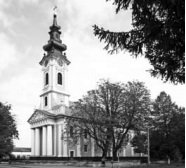North of the city of Kikinda is a large village, Mokrin. In the mentioned village in 1762 a church was dedicated to the architect Mihailo. There is a note on the cartridge, framed by the baroque-frame frame, below the icon of Jesus Christ. It is a one-nave building in a classical spirit. The west facade with a gable and a gentle bell towering over it, dimensively with the calm, broken lines. From the left and to the right side of the entrance door on the west side of the church, two characteristic pillars rise on the profiled architrave supporting tympanum.
The high baroque altar bulkhead, with woodcarving work of scratchy motifs, is the first painting by Teodor Ilić Češljar, upon his arrival at the Vienna Art Academy. It is also the only fully preserved Cesljarev iconostasis, which as such represents a significant testimony to the iconographic and artistic newspapers that have appeared. On the cartridge below the Virgin icon, there is a record of painting the iconostasis and the years of its creation-1782. On the Mokrinic iconostasis Cesljar proves that he is a mature artist with a tendency towards monumental forms and pronounced sentimentality of expression. The pictures were made on a tree coated with a thin layer of plaster. The entire iconostasis is tone and uniformly displayed, colored rich.
In the first zone, icons are overgrown with contrasts moderate and reduced to a minimum, thus achieving the sweetness of the expression. Baroque clothing and manners are obvious in drapery and hand drawings.
On the imperial doors, each of which is composed of three fields, are shown in the middle part of the Blessed One, and down the upper churches and Moses tablets. The side wings are old-fashioned scenes. On the southern doors is the Arrival of Moses, in the north- Forgiveness of Rebecca and his parents. In the scene of the Annunciation, the Virgin kneels on a pillow in front of a tall tall cathedral. The body was turned to the right, the head cloned to the opposite side, toward the angel. The shells are on gray clouds. They are dark brown in color, and small reflexes and shading are emphasized by material brass. These doors are very similar to the doors found in Ostojicevo, on the basis of which they are attributed to Cesljak.
In the second zone, there are 12 holidays in two bands, six on one and six on the other side. In the middle there is a great crossing. In the third zone there are large figures, monumental in shape and in beauty.
The interior of the church was renamed in 1927, and the paintings were cleaned by Milan Dejanović, while the ornament of the church was very successfully made by Aleksandar Sekulić. Today only icons in the upper zones are dirty. Prestone icons and those over the doors have some vertical cracks around which a few colors begin to crack.
Wall painting belongs to Nikolic Aleksic. In the altar in the upper place, Christ is depicted surrounded by the symbols of the Gospel and a multitude of angels. There are vertical cracks in the wall. The temple along the walls is a large canvas that was also taken by Nikola Aleksic. On the southern wall there are scenes: Resurrection of Lazarevo, Sv. Nikola rescues seafarers, Stoning of St. Stephen, Merciful Samaritan and Lot with Daughters. In the North: Prayer in the Garden of Gethsemane, Christ heals the weakened. From Nikola Aleksic there are standing figures of rulers and archpriests of Serbian singers in five standing figures and apostles in oval frames on the balcony of the choir. They are all in a standing position, it’s brown and ocher, and the background is gray.
On the balcony of the choir, thirteen medallions are painted on the wall of the apostles, and in the middle is Christ. In two ending medallions cut through the side walls of the church, there are two records. The record on the north side is in fact a continuation of the record from the south, which can only be read partly due to the soot deposits. The singers portrayed Serbs – rulers and saints.
SERBIAN ORTHODOX CHURCH OF ARHISTRATIG MICHAEL


0 comments on “SERBIAN ORTHODOX CHURCH OF ARHISTRATIG MICHAEL”